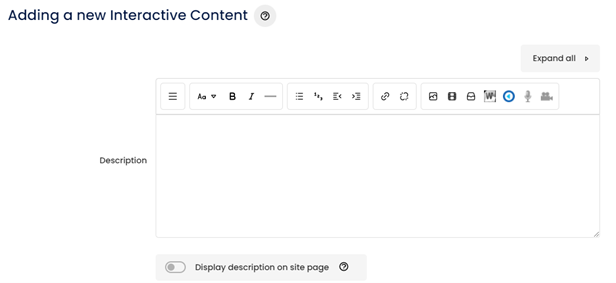Creating an H5P Fill in the Blanks activity
The H5P Fill in the Blanks activity offers educators a simple way to prompt student responses to reinforce retention of core concepts. They can function as a stand-alone H5P activity, which can be embedded into context, or be used as a question type in other H5P activities, such as:
Why?
Fill in the blanks questions are powerful assessment tools when aligned with learning objectives, designed to encourage higher-order thinking, and paired with feedback and accessibility considerations. Also known as Cloze questions, these activities effectively assess reading comprehension, vocabulary, grammar, and context. By omitting specific terms from a text, they help identify gaps in understanding. Beyond language learning, fill in the blanks questions also evaluate a learner's ability to recall facts, key terms, or make mathematical inferences.
How?
Click on the headings below to expand/collapse the section.
Alignment and authenticity
Ensure questions test essential knowledge or skills related to course outcomes (Anderson & Krathwohl, 2001). Questions should not focus on factual recall, but require students to demonstrate their understanding within a meaningful context. Consider how questions relate to 'real world' scenarios and practical knowledge.
Targeting higher-order thinking.
Use fill in the blanks questions that assess application or analysis, rather than simple recall (Brookhart, 2010). These questions should encourage students to apply knowledge in novel contexts.
For example, "Photosynthesis requires sunlight, carbon dioxide, and [blank]." could become "In conditions of low sunlight, the limiting factor in the rate of photosynthesis is [blank](water/temperature)."
Provide formative feedback
Deliver detailed, immediate feedback that helps students learn from their mistakes (Hattie & Timperley, 2007). Feedback should explain why an answer is correct or incorrect, deepening students' understanding. Additionally, guide students to next steps, such as referring back to the relevant study materials to reinforce their learning.
Design for inclusivity
Keep questions clear to avoid overloading students’ cognitive resources (Sweller et al., 2011). Avoid using multiple blanks in a single sentence or complex language that may confuse students.
To add a H5P Fill in the Blanks activity to your subject site:
- Ensure Edit mode is on.
- Click the Add an activity or resource button.

- Select Interactive Content in the Add an activity or resource chooser.

- Add a description (optional) to the activity in the Description text field. For the description to appear under the H5P activity on the site, enable the Display description on site page toggle below the description box.

- Select Fill in the Blanks from the Select content type menu.
- Follow the step-by-step guidance in the Fill in the Blanks Tutorial H5P support resource.
- When the setup process is complete, click the Save and return to site button.
Your H5P Fill in the Blanks activity is now ready for use.
Related information
- Creating an H5P Course Presentation activity | L&T Hub resource
- Creating an H5P Interactive Video Activity | L&T Hub resource
- Fill in the Blanks Tutorial | External resource
- Using Question Sets in H5P | External resource
References
Anderson, L. W., & Krathwohl, D. R. (2001). A taxonomy for learning, teaching, and assessing: A revision of Bloom’s taxonomy of educational objectives. Longman.
Brookhart, S. M. (2010). How to assess higher-order thinking skills in your classroom. ASCD.
Hattie, J., & Timperley, H. (2007). The power of feedback. Review of Educational Research, 77(1), 81-112.
Sweller, J., Ayres, P., & Kalyuga, S. (2011). Cognitive load theory. Springer.



